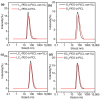Study of Polyethylene Oxide- b-Poly(ε-caprolactone- ran- δ-valerolactone) Amphiphilic Architectures and Their Effects on Self-Assembly as a Drug Carrier
- PMID: 40284295
- PMCID: PMC12030258
- DOI: 10.3390/polym17081030
Study of Polyethylene Oxide- b-Poly(ε-caprolactone- ran- δ-valerolactone) Amphiphilic Architectures and Their Effects on Self-Assembly as a Drug Carrier
Abstract
Amphiphilic block copolymers with complex topologies (e.g., star and brush topologies) have attracted significant attention in drug delivery owing to their superior performance over linear micelles. However, their precise synthesis and structure-property relationships require further investigation. In this study, hydroxylated polybutadiene with adjustable topology and hydroxyl group density was employed as a macroinitiator to synthesize well-defined amphiphilic poly (ethylene oxide)-b-poly(ε-caprolactone-ran-δ-valerolactone) (PEO-b-P(CL-ran-VL)) copolymers via ring-opening polymerization (ROP). A series of linear, star, linear-comb, and star-comb copolymers were prepared as curcumin-loaded micellar carriers for the study. The self-assembly behavior, drug encapsulation efficiency, and in vitro release profiles of these copolymers in aqueous environments were systematically investigated. The results demonstrated that increasing the branch length of star-comb copolymers effectively reduced micelle size from 143 to 96 nm and enhanced drug encapsulation efficiency from 27.3% to 39.8%. Notably, the star-comb architecture exhibited 1.2-fold higher curcumin encapsulation efficiency than the linear counterparts. Furthermore, the optimized star-comb nanoparticles displayed sustained release kinetics (73.38% release over 15 days), outperforming conventional linear micelles. This study establishes a quantitative structure-property relationship between copolymer topology and drug delivery performance, providing a molecular design platform for programmable nanocarriers tailored to diverse therapeutic requirements of various diseases.
Keywords: amphiphilic copolymers; architectures; drug delivery; self-assembly.
Conflict of interest statement
Author Tong Wu was employed by the company SINOPEC Ningbo New Materials Research Institute Company Limited. The remaining authors declare that the research was conducted in the absence of any commercial or financial relationships that could be construed as potential conflicts of interest.
Figures









Similar articles
-
Fine tuning micellar core-forming block of poly(ethylene glycol)-block-poly(ε-caprolactone) amphiphilic copolymers based on chemical modification for the solubilization and delivery of doxorubicin.Biomacromolecules. 2011 Jul 11;12(7):2562-72. doi: 10.1021/bm200375x. Epub 2011 Jun 6. Biomacromolecules. 2011. PMID: 21598958
-
Fabrication of supramolecular star-shaped amphiphilic copolymers for ROS-triggered drug release.J Colloid Interface Sci. 2018 Mar 15;514:122-131. doi: 10.1016/j.jcis.2017.12.022. Epub 2017 Dec 7. J Colloid Interface Sci. 2018. PMID: 29248814
-
Preparation of Doxorubicin-Loaded Amphiphilic Poly(D,L-Lactide-Co-Glycolide)-b-Poly(N-Acryloylmorpholine) AB2 Miktoarm Star Block Copolymers for Anticancer Drug Delivery.Materials (Basel). 2020 Aug 22;13(17):3713. doi: 10.3390/ma13173713. Materials (Basel). 2020. PMID: 32842626 Free PMC article.
-
Synthesis of amphiphilic tadpole-shaped linear-cyclic diblock copolymers via ring-opening polymerization directly initiating from cyclic precursors and their application as drug nanocarriers.Biomacromolecules. 2011 Apr 11;12(4):1146-54. doi: 10.1021/bm101463d. Epub 2011 Feb 18. Biomacromolecules. 2011. PMID: 21332208
-
Synthesis approaches of amphiphilic copolymers for spherical micelle preparation: application in drug delivery.J Mater Chem B. 2023 Oct 11;11(39):9325-9368. doi: 10.1039/d3tb01371e. J Mater Chem B. 2023. PMID: 37706425 Review.
References
-
- Ozawa N., Nishimura T. Macromolecular architectural effects on solution self-assembly of amphiphilic AB-type block copolymers. Polym. Chem. R. Soc. Chem. 2024;15:349–370. doi: 10.1039/D3PY01324C. - DOI
-
- Kang G.-Y., Ma W., Liu M.-Z., Luo H.-X., Yu C.-Y., Wei H. Expanding Cyclic Topology-Based Biomedical Polymer Panel: Universal Synthesis of Hetero-“8”-Shaped Copolymers and Topological Modulation of Polymer Degradation. Macromol. Rapid Commun. 2021;42:2100298. doi: 10.1002/marc.202100298. - DOI - PubMed
LinkOut - more resources
Full Text Sources
Miscellaneous

